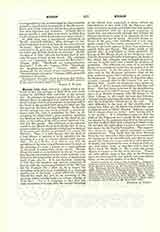

Hyssop (AZVB; Sept. ussopos), a plant which is referred to in a few passages of Holy Writ, and which cannot be identified with certainty at the present day. Its existence in Egypt is proved by Ex., xii, 22, wherein Moses is represented as bidding the elders of Israel to take a bunch of hyssop and to sprinkle with it the blood of the paschal lamb upon the lintel and the side posts of the doors of their dwellings. In the wilderness hyssop was also ready at hand, as can be inferred from Ex., xxiv, 8, completed by Heb., ix, 19, according to which Israel’s great lawgiver sprinkled the Hebrews with hyssop dipped in the blood of victims, at the sealing of the old covenant between Yahweh and His people. The references to hyssop contained in the Mosaic ritual show clearly that it was a common plant in the peninsula of Sinai and in the land of Chanaan, and disclose its principal uses among the Hebrews. Thus, it is with hyssop that the blood of a bird offered in sacrifice is to be sprinkled for the cleansing of a man or a house affected with leprosy (Lev., xiv, 4-7, 49-51); it is with it, too, that the sprinkling of the water of purification must be made at the cleansing of a tent, a person, or a vessel polluted by the touch of a dead body (Num., xix, 8). Besides being thus used as an instrument in the act of sprinkling, hyssop was employed as one of the elements to be burned in the preparation of the water of purification itself (Num., xix, 6). It is not therefore surprising to find that this manifold and intimate connection of hyssop with the various purifications of the Old Law led the Psalmist (Ps. 1 [Heb. li], 9) to regard the sprinkling with hyssop as symbolical of a thorough purification of the heart, a view which the Catholic Church has made her own in the ceremony of the Asperges which usually begins the solemn offering of Holy Mass. Nor is it surprising to find that this same connection of hyssop with the various cleansings of the Mosaic Law suggested to many writers the identification of that plant with the Hysso pus officinalis, or common hyssop, with which they were particularly acquainted, and the detergent properties of which they not unnaturally thought had induced the Hebrew legislator to select it as especially fit for the purificatory services in Israel. However widely received in the past, such identification is now commonly rejected for this reason, among others, that the’ Hyssopus officinalis appears to have been unknown in ancient Syria and Egypt. The plant, which at the present day, is considered as more probably the hyssop of the Mosaic ritual, is the Origanum maru. Like the Hysso pus officinalis it belongs to the family of the labiatae, has aromatic and detergent properties, and can be easily made into a bunch for purposes of sprinkling. The following are some of its particular claims to be considered as the hyssop spoken of in the Old Testament. In the first place, it is to the Origanum—not to the Hyssopus officinalis—that all ancient tradition points when referring to the hyssop of the Scriptures. In the next place, its Egyptian name of supho, is clearly allied to the Aramaic zufo and the Hebrew ez8b. Lastly, the Origanum maru grows on the walls of all the terraces throughout Palestine and Syria. This last claim in favor of the identification of the hyssop of the Old Testament with the Origanum maru, is in distinct harmony with III Kings, iv, 33 (Heb. I Kings, iv, 33) where we read that Solomon “treated about trees from the cedar that is in Libanus, unto the hyssop that cometh out of the wall”. The chief difficulty in the way of this identification is drawn from John, xix, 29, where it is stated that some of those present at Christ’s Passion “putting a sponge full of vinegar about (or rather: upon) hyssop, put it to his mouth”. It is oftentimes supposed that the stalk of the Origanum maru would be too short and too slender for the purposes described in this passage, and that another plant with a longer and firmer stem, for instance, the caper-plant (capparis spinosa) is the one meant by the Fourth Evangelist. This supposition, however, does not appear necessary to many commentators. They think that the cross whereon Jesus lay was not such a lofty object as is assumed by the opponents of the identification, and that in consequence the Origanum maru, some 40 or 50 centimeters in length, and undoubtedly near at hand on Calvary, was used either alone, or together with a reed (cf. Matt., xxvii, 29; Mark, xv, 36) to carry the sponge dipped in vinegar to the lips of the Savior. Numerous other plants, more or less akin to the Origanum maru are also regarded, and indeed with some probability, as the hyssop spoken of in Holy Writ.
FRANCIS E. GIGOT

